Live show air date: May 7, 2020
Episode 7 Video and Show Notes
Join me for Elevenses with Lisa, the online video series where we take a break, visit and learn.
This episode is a follow up to material covered in Episode 6. You will enjoy it much more if you watch episode 6 first. Then click the video below to watch Episode 7, and scroll down for all the show notes and details.
Today’s Teacup:
Aynsley Bone China from England
The company was founded in 1775 by John Aynsley in Lane End, Longton, Staffordshire.
From You:
Lori writes:
I know you are asking what we have been doing and I wanted to share this with you.
I have an old photo of my mother’s side of the family and they are sitting down at the table to celebrate my GG Grandmother’s birthday.
Anyway I am a tea cup collector and tea drinker and so was my great grandmother who is also in the photo to the right holding onto my mom.
I wanted to find her china and as you can see this photo is not very good at being able to identify. I sent a close up of this picture on the china pattern to Replacements LTD.com and they were able to help me find the china and pattern!
Here is the photo of the family (and) the china pattern that they helped me discover. I didn’t know that you could send them a photo so when I discovered this I have been telling everyone!
Love the Elevenses show!
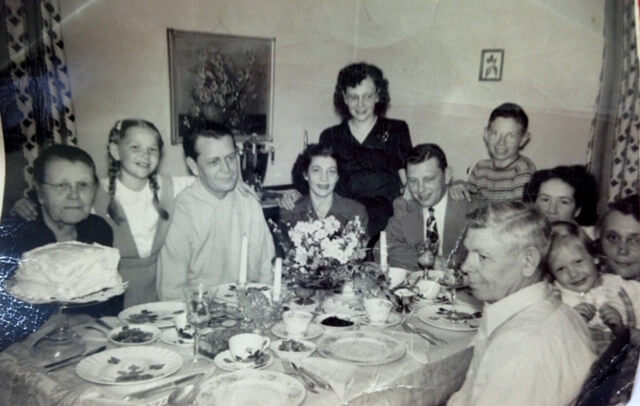
Lori’s family and their lovely china place settings.

ReplacementsLTD.com identified Lori’s china pattern!
Family History DIY Project
You may have noticed the watch on my wrist in this episode. I don’t usually wear a watch, but this actually isn’t a watch. It’s a DIY bracelet that I created using one of my grandmother’s old watches.
Click to watch (below) how you can make one yourself:
Learn more at Genealogy Gems DIY here.
Follow me for more Family History DIY ideas:
Instagram: Lisa Louise Cooke at www.instagram.com/genealogygems
Pinterest: Lisa Louise Cooke Genealogy Gems at www.pinterest.com/lisalouisecooke/
Answers to Your Questions About My Genealogy Organization Method
From Julie
Q: How do you handle legal size papers?
and from MargtheCar
Q: What do you do about oversize documents, panorama photos etc that don’t fit in a binder?
A: Hopefully you won’t have a lot. You can use a legal size binder like this one, or an archival safe box. Gaylord
From Joyce
Q: What weight of protectors?
A: Avery Heavyweight 3.3 mils #76003
From Linda
Q: Do you put each sheet of a letter in a separate sheet protector or do you put the entire letter in the one sheet protector?
A: One each although sometimes I place one-sided items back to back. You can slip a piece of acid-free paper or cardstock between them if you wish.
From Kathryn
Q: Does it matter whether the binders themselves are archival?
A: As long as everything is in the archival safe sheet protectors they should be fine. Gaylord makes a 3 ring archival box but it’s expensive – about $30 each
From Betty in the Episode 6 Show Notes Comments
Q: Beginning with “the 4 ancestral lines”…don’t those notebooks become extremely large? Have you gone from a 3” on a name and then added a second for same line?
A: For a few family lines (the ones closest to me because they have the most archival paper) I do have multiple binders. I indicate on the spine the time frame that the binder covers.
From Marilyn
Q: For a couple do you make a copy and file it in both of their binders.
A: A couple is in the same binder. The wife goes behind the head of household tab.
From Pamela
Q: Do you move the women into another binder when they married and how do you make a note in her birth family binder?
A: The last item in the father’s binder should be her marriage application / license. This tells you the surname of her fiancé. If she is a direct ancestor I create a new binder for her husband’s surname. You are welcome to put a sheet of paper that references the new binder, although my database would also tell me who her husband was, so I would look for that binder. I would only create a binder if there was enough material to warrant it, and if she were a direct ancestor.
From Ginny
Q: Are the male sons listed with their father until they marry?
A: Yes – they only move to a new binder if paper warrants it and they are a direct ancestor.
From Keck
Q: Do you put photos in the same binders?
A: Yes, for now. I’m setting up archival boxes. If you have a lot of old family photos, I recommend storing them separately. However, I think it’s wonderful to scan them and print copies of some of your favorites to include in their section of the binder.
From Pamela
Q: Do you scan all your paper and keep it organized on your computer as well?
A: Yes, if it’s worth keeping for future reference. I don’t keep all paper though. I only keep and archive paper items that are precious and irreplaceable. My goal is to download the digital records I find online and store them on my computer (which is backed up with Backblaze.) And keep in mind, there is no pressure to file ALL paper before resuming your genealogy research. I schedule regular scanning time, for my backlog, and I scan and file as I go with current research. Eventually you will get caught up.
From Susie
Q: Do you mark the paper to show that it is also digitized?
A: Yes, with a pencil check mark. Or you could use a thin sharpie and mark the sheet protector.
From Regina
Q: Do you keep copies of census records in your files? Or do you rely on the big name websites and attach it to an online tree?
A: Not typically, although I have kept a few from when I first started my research when I was a kid. Now I download the digital file and save it on my hard drive which is backed up to the cloud.
From Kay
Q: Do you put new items in your heirloom binder? e.g. a gift you received that you think will be passed on? {of course, some things need to go in a will.)
A: Yes, absolutely!
From Carol
Q: I’ve really been enjoying your YouTubes and have become a member. I love the idea of the heirloom template, but for some reason when I try to insert a picture, only a small portion shows. I’m obviously doing something wrong. Would you do a quick summary of how to insert the picture?
A: I’m going to show you how to do that, and the best way to find all of the show notes:

Stay in control of your genealogy.
Article Mentioned in this Episode
Read my article: Planting Your Master Genealogy Family Tree
Online Family Trees:
Pros:
- Good for cousin connections
- Good for generating hints
- Good place to track and test ideas
Cons:
- Controlled by someone else
- Can only access documents with a subscription
- Inaccurate trees
I use my online tree as a lead generator, NOT a master tree.
Do the Genealogy 2-Step to Protect Your Family Tree
Step 1: Purchase a genealogy software program and load it on your computer
Step 2: Back up your entire computer with a cloud-based backup service
The best type of backup protection involves:
- Multiple copies
- Updated regularly
- At least one copy stored in a different physical location than your computer
What I look for in a cloud backup service:
- Backup of all files automatically (including video!)
- Free app for accessing files on mobile
- Encryption and security
- Ease of restoration
- Competitive price
I use Backblaze. If you decide to check them out, please use this Backblaze link. If you do we are compensated at no additional cost to you, and that supports the free Elevenses with Lisa show. Thank you! Whatever you choose, start backing up today!
More Answers to Questions About Genealogy Organization
From Jennifer
Q: Do you use the card catalog (behind you) for family “cards” to show what you have and what is filed where?
A: No. My database is my master. If I need to know something about someone in my family tree, I look them up in my database. That is the final word on what I currently know about them. Armed with that information I then know where to look in my computer digital files, and in which binder I will find the archival paper.
From Julie
Q: Do you reference the documents in your regular binders so you know how to find them?
A: No. My database is where I turn because it is the most accurate and up to date information on each person in my tree. If I need documentation on any aspect of a person’s life, I turn to my hard drive where the bulk of my documents are. If it’s not there (although it probably is because I scan my archival paper) then I pull the family binder. I can ALWAYS find what I need. I’m happy to say that I haven’t lost an item yet.
From Keck
Q: Do you have a Table of Contents in each binder?
A: No – it’s chronological and matches my database. See my previous answer to Julie above.
From Sherry
Comment: Cross referencing is great and saves in duplicating paper…that being said, put a cross reference sheet in the front of each binder and list each item that you reference on that sheet.
A: I designed my system so that I would not have to cross reference. People are not duplicated in multiple binders because they can only be in one household at a time. They are either in their father’s household, or their own household. (Yes, an adult may live or rent from someone else, but they are still their own “head of household”.) The database is my guide as to their surname and the life events which is the information I need in order to know which binder to look in. This is the beauty and the simplicity of this system. All filing and organization is driven by the master database. And remember, the goal is keeping the least amount of paper possible. Most items will be digital on your computer.
From Stephen
Q: If you have both paper and digital of the same document, do you discard the paper once done with it and reference the digital version in the binder?
A: I discard the paper if it’s not archival-worthy. (In other words, it is not previous, irreplaceable or highly sentimental. Most isn’t.) There’s no need to reference the digital version. If I need backup documentation on anything noted in my database, I know where to find it on my hard drive. We’ll talk more about hard drive organization in Episode 8. There is also an in-depth two part video series on how to do it step-by-step in Genealogy Gems Premium Membership. (Learn more about membership here)
From Karen
Q: My big problem is I have about 8 different Brown families. How do I label them to know which is which?
A: My first questions would be, are all of them direct lines? I tend to archive only the most important items for direct ancestors. Digitize the rest, and toss the paper. If they are collateral relatives you can also file their paper in the direct line binder under the Collateral tab.
You can also include the unique number assigned to the person in Rootsmagic, or use their birth year to identify each unique Brown head of household.
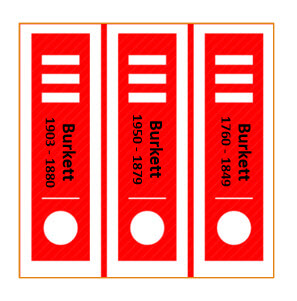
Multiple genealogy binders for one family
From Keck
Q: Do you duplicate that in Evernote or in your digital file for the same family?
A: Evernote is my “active workspace”. It is not a complete look at my research. It is only the notes and clippings associated with my research. The paper organization we’re talking about is archival. All genealogy records are digital on my computer. If you want to remind yourself about an archived item, you can certainly make a mention of it in your Evernote notes.
From Jennifer
Q: I’d like to list on Twitter for you and Facebook, are we doing Elevenses with Lisa for forever or are we just looking at May for now? (I want to open the invite.)
A: I plan on continuing indefinitely. I have nowhere to go! And besides, I love meeting with you all each week. thank you for sharing the show – I really appreciate it!

Thank you for sharing Elevenses with Lisa with your friends and genealogy society!
In the Next Episode of Elevenses with Lisa:
- Filing digital genealogical files
- Naming digital files
- Filing digital photos
Resources for Further learning:
These video classes (each with a downloadable handout) are included in Genealogy Gems Premium Membership and will help you further implement my system and become more productive (Members log in and then click the image to watch the video and download the handout):
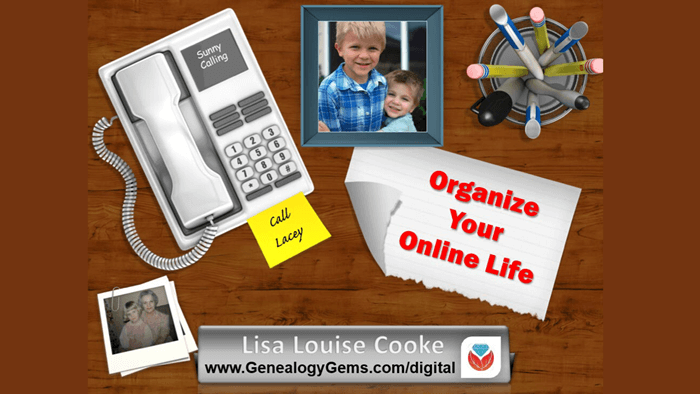
One hour video class.
Join me for exclusive videos, handouts and podcast episodes. Click the button below to become a Genealogy Gems Premium Member.
Do you have a questions about organizing your genealogy?
Please leave your questions and comments below.

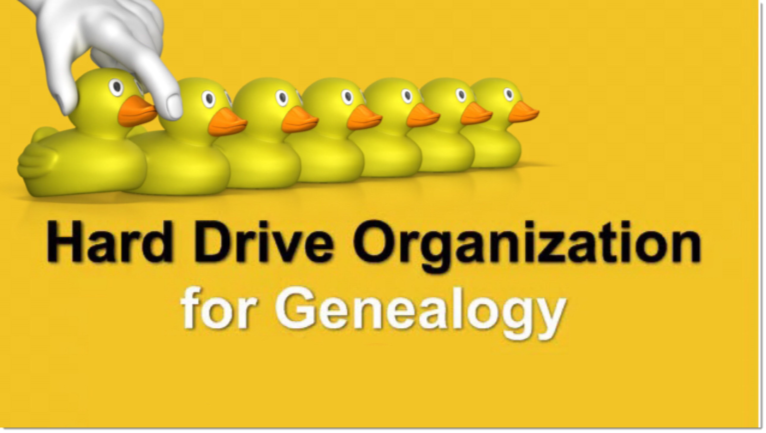
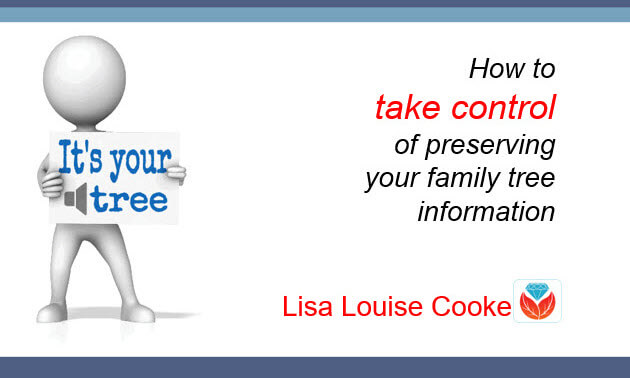





Jasso family had three sons and three daughters. I understand that the daughters move to a new binder when they marry and go after their husband. However, when the son marries do you leave the tab for him under his father? Also, would his wife and children go behind him in the same Jasso binder or does he start a new Jasso binder?
Generally speaking I only create binders for direct ancestors. This works when you keep in mind that we are trying to save and archive only the most precious paper – everything else is digitized and stored on our computer. So if the son is your director ancestor, then he gets his own TAB (not binder). In other words, if his father is your great grandfather (who is in the surname binder and has a tab as head of household), and his son is your grandfather, then the son (your grandfather) is the next tab in that surname book. The tabs in the binder are by generation. And the women go to a new binder only if 1) they marry a direct ancestor or 2) it is warranted because there is a large volume of precious, archival-worthy paper for her.
Lisa,
I am enjoying the elevenses series and getting the push I need to get started in digging out my geneology clutter.
More on archival storage: Everyoneshould beware that acid free is no the same as archival. Archival storage ideas: Photography and art storage supplies are available in archival form in muliple sizes and formats such as sleeves/sheet protectors, slip in envelopes, boxes, protfolios with or without zippers and flat files (for a large amount of storage). Also available are special gloves for handilg photos and documents (Fingers leave grease which can cause deterioration over time) and loupes for viewing up close. My first choice would be to check local art and photography stores where you can see what is available and support your local businesses as they reopen, then major photo suppliers such as B&H and Adorama and on-line art suppliers and LAST Amazon because at the others you can ask questions and get help for what you actually need.
If you have a lot of photos, consider watching for sale on “memory boxs” which are digitized scans of multiple photos.
Malka
So glad you’re enjoying the show! Yes, there are many options and thank you for sharing your ideas. Click here for a wealth of articles on our website regarding archival preservation. I would add that many of these archival items are quite expensive and out of reach for some, particularly with the volume of material they may have. Acid-free sheet protectors are a very affordable option to get started right away and will serve the hobbyist well. Our goal is to take all steps we can reasonably take to slow the potential deterioration.
Are the Show Notes after each session printable without all of the pictures, etc.? I would like a hard copy to go over what was presented .
Thanks, Louise
You can use Evernote to save the page in a “Simplified” form using the web clipper. That will save just the text for you as a note.
I’m having trouble with deciding photos to archive versus digitize and toss. If I’m thrilled to have these old photos from the 1900s whose to say 100 years from now someone wouldn’t be thrilled to have this photo that was printed in the 70s?
Excellent point! Our photos from the ’70s are already quite a novelty – printed on paper. That’s something our kids and grandkids don’t see much of. I’ve been digitizing then tossing those that are not great photos, are duplicates, or people I barely knew. That has at least thinned it down.
Greetings Lisa:
Liking your Elevenses Episodes.
Just listened to Elevenses #9 and the part that mentioned about one’s “Master Database”
…then went to Episode #229.
When I started my tree, I placed everything online—Ancestry and used Family Tree Maker(Desktop/Discs) for many years. I’ve been adding obituaries(acquired recently 85 family obits) and other stories online—keeping them in cloud and storage.
My question, since I have all my information online, Ancestry, where do I start on my
local computer of having that “Master Database(MD)”?
Do I sync with Ancestry OnLine with the desktop software…then, start with that MD on desktop; afterward, adding branches to online?
Do I create a GEDCOM and import that Database into a fresh Family File on desktop software?
Thanks again for your insights and help.
Hugh
Hi Hugh, Both of those are options. It depends on what condition you think your Ancestry tree is in. If you feel it’s solid and well documented, I think syncing to a new software file is a good way to go. Then you would make your ongoing entries first in your software and sync up with the online tree. (If indeed you want your entire tree to remain on Ancestry.) I’ve heard from folks that felt like their online tree was a mess, that they just started a new file in the database, and used it as an opportunity for a redo. They comb through their online tree or export the GEDCOM and then add it to their software, checking their assumptions, adding source citations, photos etc. as they go. The key is to convert to your software being your “final say” and your online tree can either be a synced mirror of that, or a modified version only focusing on the lines of most importance to you.